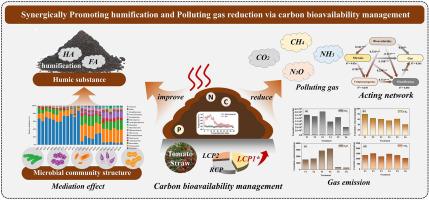通过碳生物有效性管理协同促进樱桃番茄秸秆堆肥腐殖质化和减少污染气体
IF 7.3
2区 环境科学与生态学
Q1 ENVIRONMENTAL SCIENCES
引用次数: 0
摘要
堆肥腐殖化水平与污染气体减排的协同控制是好氧堆肥长期面临的挑战。已有大量研究报道了不同碳源类型或总碳氮比对堆肥腐殖化的影响;然而,只有少数人探讨了碳组成的作用,特别是从生物可利用量化的角度。本研究旨在阐明生物有效碳组成的协同效应,并系统探讨驱动堆肥的相互作用机制。从污染气体排放、堆肥特性、腐殖质化和微生物群落结构四个方面对不同生物有效碳含量的6个堆肥试验进行了分析。结果表明,提高生物有效碳的比例促进了堆肥中有机质、总养分和速效养分的转化,并提高了堆肥的腐殖化水平。生物可利用碳的轻微增加在一定程度上导致气体排放量(CO2当量排放量)增加。只有当有效碳比I (ACC1)的比例超过60.31%(阈值,T5处理)时,堆肥腐殖化水平和气体减排效果才会同时提高。在T5处理下,氧化亚氮的还原率达到76.98%,对全球变暖潜势的贡献降至21.0%。本研究中,活性碳组分直接参与腐殖化过程,并通过微生物群落的调解间接增强堆肥腐殖化,减少污染物气体排放。总体而言,本研究构建了多个堆肥参数之间的综合关联网络,并确定了LCP1是碳生物利用度的关键碳组分。研究结果为实际应用中综合提高堆肥腐殖化效率、堆肥质量和减少气体排放提供了理论依据和实证支持。本文章由计算机程序翻译,如有差异,请以英文原文为准。

Synergistically promoting humification and polluting gas reduction in cherry tomato straw composting via carbon bioavailability management
The synergistic control of composting humification level and polluting gas emission reduction is a persisting challenge in aerobic composting. Numerous previous studies reported that the effects of various carbon source types or the total C/N ratios on the compost humification; However, only a few explored the role of carbon composition, particularly from a bioavailable quantization perspective. This study aimed to clarify the synergistic impact of bioavailable carbon composition and systematically accessed the interaction mechanisms that drove the composting. Six composting experiments with different content of bioavailable carbon were conducted and analyzed from four aspects, polluting gas emissions, compost characteristics, humification, and microbial community structure. The results indicated that a higher proportion of bioavailable carbon enhanced the transformation of organic matter, total nutrient, and available nutrient, accompanied by enhanced humification level of the compost. A slight increase in bioavailable carbon led to higher gas emissions (CO2 equivalent emissions) to some extent. Only when the proportion of available carbon proportion I (ACC1) exceeded 60.31% (threshold value, T5 treatment) did the compost humification level and gas emission-reduction effect improve simultaneously. Under the T5 treatment, the nitrous oxide reduction rate reached 76.98% with its contribution to global warming potential decreasing to 21.0%.In this study, labile carbon component directly participated in the humification process and also indirectly enhanced the humification of compost and reduced pollutant gas emissions through the mediation of microbial communities. Overall, this study presented a comprehensive correlation network that links multiple composting parameters and identified the LCP1 was the key carbon component of carbon bioavailability. The findings offer a theoretical basis and empirical support for integrated improvement of compost humification efficiency, compost quality, and gas emission reduction in practical applications.
求助全文
通过发布文献求助,成功后即可免费获取论文全文。
去求助
来源期刊

Environmental Pollution
环境科学-环境科学
CiteScore
16.00
自引率
6.70%
发文量
2082
审稿时长
2.9 months
期刊介绍:
Environmental Pollution is an international peer-reviewed journal that publishes high-quality research papers and review articles covering all aspects of environmental pollution and its impacts on ecosystems and human health.
Subject areas include, but are not limited to:
• Sources and occurrences of pollutants that are clearly defined and measured in environmental compartments, food and food-related items, and human bodies;
• Interlinks between contaminant exposure and biological, ecological, and human health effects, including those of climate change;
• Contaminants of emerging concerns (including but not limited to antibiotic resistant microorganisms or genes, microplastics/nanoplastics, electronic wastes, light, and noise) and/or their biological, ecological, or human health effects;
• Laboratory and field studies on the remediation/mitigation of environmental pollution via new techniques and with clear links to biological, ecological, or human health effects;
• Modeling of pollution processes, patterns, or trends that is of clear environmental and/or human health interest;
• New techniques that measure and examine environmental occurrences, transport, behavior, and effects of pollutants within the environment or the laboratory, provided that they can be clearly used to address problems within regional or global environmental compartments.
 求助内容:
求助内容: 应助结果提醒方式:
应助结果提醒方式:


